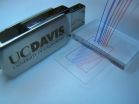Forget Farmville, here's a game that drives genetic research
McGill researchers develop game that uses players' moves to analyze genetic sequences
2010-11-30
(Press-News.org) Playing online can mean more than killing time, thanks to a new game developed by a team of bioinformaticians at McGill University. Now, players can contribute in a fun way to genetic research. "There are some calculations that the human brain does more efficiently than any computer can, such as recognizing a face," explained lead researcher Dr. Jérôme Waldispuhl of the School of Computer Science. "Recognizing and sorting the patterns in the human genetic code falls in that category. Our new online game enables players to have fun while contributing to genetic research – players can even choose which genetic disease they want to help decode." The game is called Phylo and can be played at http://phylo.cs.mcgill.ca.
The game has been tested within the scientific community to ensure its accuracy, but was officially launched today at 11 a.m. "We're hoping that people will enjoy playing the game and that many participants will sign up," Waldispühl said. "This is an opportunity for people to use their free time to contribute in an extremely important way to medical research." Many human diseases are caused by defects in the DNA code, and researchers are only just beginning to unravel this link.
Beyond offering the general public an opportunity to get involved in this research, the game is also useful for teaching the next generation of genetics researchers about their field. "The precise genetic cause of most diseases is not known, but thanks to Phylo gamers, this research could be significantly improved," said Dr. Alain Denise, a Bioinformatics and Computational Biology researcher at the University of Paris-Sud 11.
The researchers have their sights set high for the future of the game. "We would like to integrate this game directly into Facebook as an application. Farmville, move over!"
INFORMATION:
For more information:
Phylo – a game which enables you to sort genetic code: http://phylo.cs.mcgill.ca/
McGill's School of Computer Science: http://www.cs.mcgill.ca/
Computational Structural Biology Group: http://csb.cs.mcgill.ca/
McGill Centre for Bioinformatics: http://www.mcgill.ca/mcb/
ELSE PRESS RELEASES FROM THIS DATE:
2010-11-30
One person correctly remembers four of eight items just seen but is fuzzy on details. Another person recalls only two of the items but with amazingly precise clarity. So what ability translates to higher IQ?
According to a University of Oregon study, the answer is very clear: More items stored in short-term memory is linked to greater fluid intelligence, as measured in IQ tests. The resolution of those memories, while important in many situations, shows no relationship with fluid intelligence.
The notion that numbers of items is vitally important to short-term memory ...
2010-11-30
PITTSBURGH, Nov. 29 – Breast cancers that arise sporadically, rather than through inheritance of certain genes, likely start with defects of DNA repair mechanisms that allow environmentally triggered mutations to accumulate, according to researchers at the University of Pittsburgh School of Medicine, Magee-Womens Hospital of UPMC and the University of Pittsburgh Cancer Institute. The findings, reported this week in the early online edition of the Proceedings of the National Academy of Sciences, indicate that potent chemotherapy drugs that target DNA in later-stage cancers ...
2010-11-30
PHILADELPHIA - Mimicking the reflective iridescence of a butterfly's wing, investigators at the University of Pennsylvania School of Medicine and School of Engineering and Applied Sciences have developed a color-changing patch that could be worn on soldiers' helmets and uniforms to indicate the strength of exposure to blasts from explosives in the field. Future studies aim to calibrate the color change to the intensity of exposure to provide an immediate read on the potential harm to the brain and the subsequent need for medical intervention. The findings are described ...
2010-11-30
As employees become increasingly anxious about job security and financial worries during an economic recession, satisfaction with the job they have, commitment to their company and engagement with their work are all affected detrimentally. This trend could be self-fulfilling in that disengaged employees could have a negative impact on a company's products or services and lead to its decline which would inevitably see the company failing.
Researchers in business and management have now formulated a model of how such employee engagement can change during an economic downturn. ...
2010-11-30
Christmas time is the time for mulled wine. And that tastes best at a Christmas market. So that market goers get home safely, the police are increasing their drink driving checks on car drivers right now. Those who are asked to blow into the device in this type of traffic check can be sure that the value the device displays after a short time is correct. This is because the "synthetic breath" - which helps to thoroughly test each newly developed evidential breath analyser in approval procedures at the Physikalisch-Technische Bundesanstalt (PTB) - can now be produced even ...
2010-11-30
COLUMBIA, Mo. ¬¬¬–Gold nanoparticles, tiny pieces of gold so small that they can't be seen by the naked eye, are used in electronics, healthcare products and as pharmaceuticals to fight cancer. Despite their positive uses, the process to make the nanoparticles requires dangerous and extremely toxic chemicals. While the nanotechnology industry is expected to produce large quantities of nanoparticles in the near future, researchers have been worried about the environmental impact of the global nanotechnological revolution.
Now, a study by a University of Missouri research ...
2010-11-30
Tel Aviv - In the human brain, mechanical stress -- the amount of pressure applied to a particular area -- requires a delicate balance. Just the right force keeps neurons together and functioning as a system within the body, and proper nerve function is dependent on this tension.
Now researchers at Tel Aviv University say that mechanical stress plays an even more important role than medical science previously believed. Their research has the potential to tell us more than ever before about the form and function of neuronal systems, including the human brain. And they've ...
2010-11-30
Giving emergency artesunate suppositories to children with suspected severe malaria before referring them for treatment is a cost-effective intervention that can substantially improve the management of childhood malaria in remote African settings, according to a new study led by Boston University School of Public Health [BUSPH] researcher Yesim Tozan, PhD, (link to profile: http://sph.bu.edu/tozan)
The study, which appears online Nov. 29 in The Lancet , builds on previous research that found that the administration of one dose of rectal artesunate by a community health ...
2010-11-30
Can a road-trip across eastern North America, ancient ice sheets, and DNA samples unlock the ancestral history of jack pine trees? Julie Godbout and colleagues from the Université Laval, Quebec, Canada, certainly hoped that driving across northeastern U.S. and Canada to collect samples from jack pine trees would shed some light on how glaciers may have impacted present-day pine genetics.
About 20,000 years ago, ice sheets covered most of the northern terrestrial surface of the continent of North America. For some boreal species this Last Glacial Maximum period may ...
2010-11-30
Biomedical engineers at UC Davis have developed a plug-in interface for the microfluidic chips that will form the basis of the next generation of compact medical devices. They hope that the "fit to flow" interface will become as ubiquitous as the USB interface for computer peripherals.
UC Davis filed a provisional patent on the invention Nov. 1. A paper describing the devices was published online Nov. 25 by the journal Lab on a Chip.
"We think there is a huge need for an interface to bridge microfluidics to electronic devices," said Tingrui Pan, assistant professor ...
LAST 30 PRESS RELEASES:
[Press-News.org] Forget Farmville, here's a game that drives genetic research
McGill researchers develop game that uses players' moves to analyze genetic sequences




